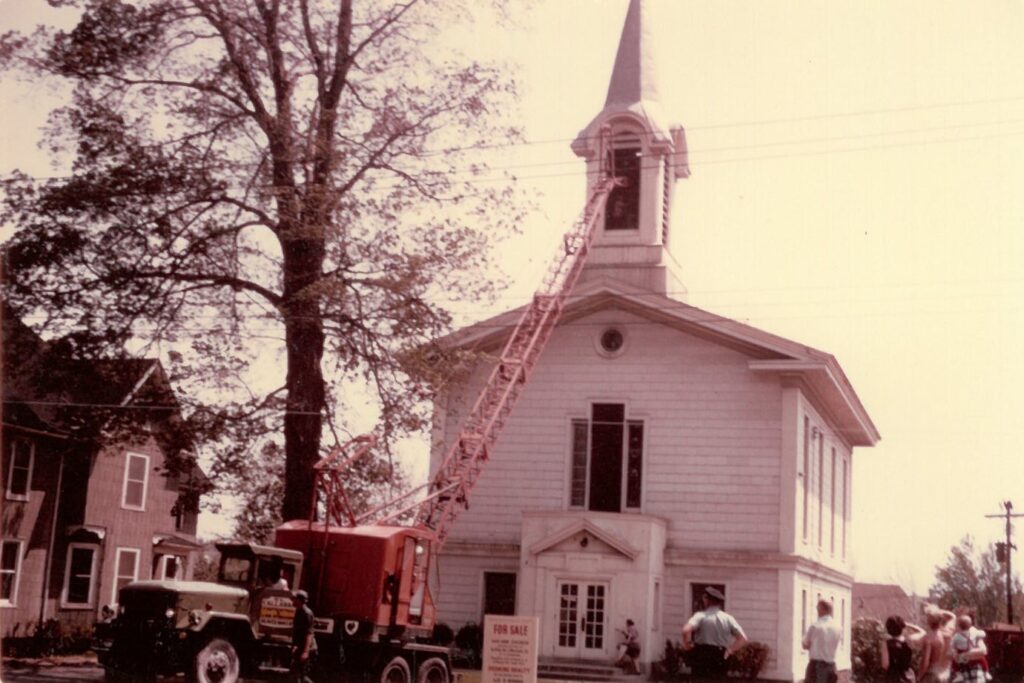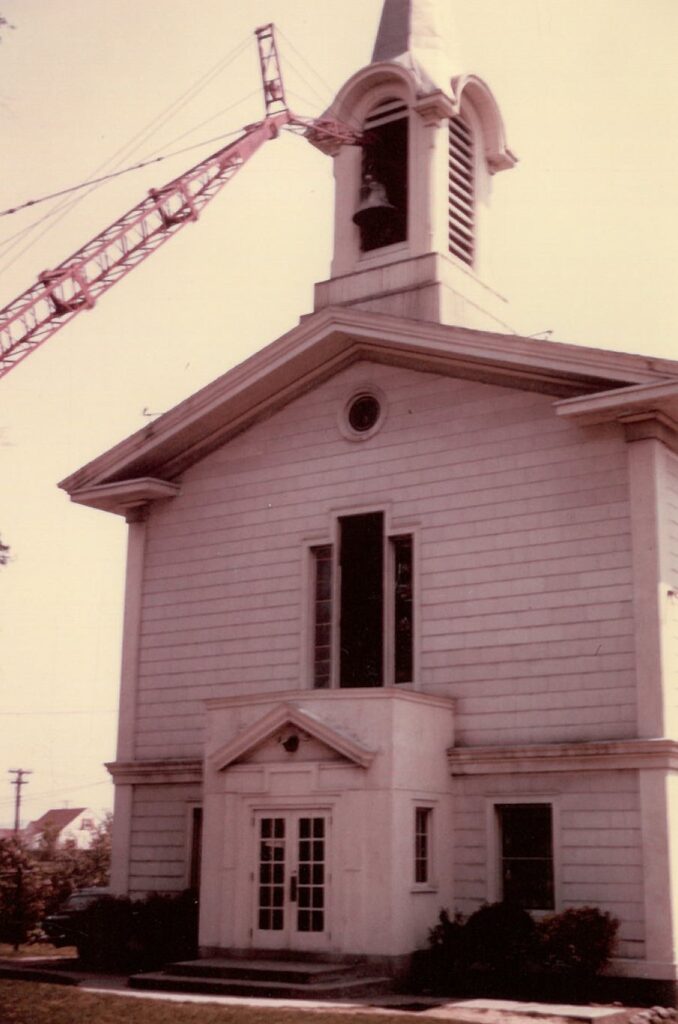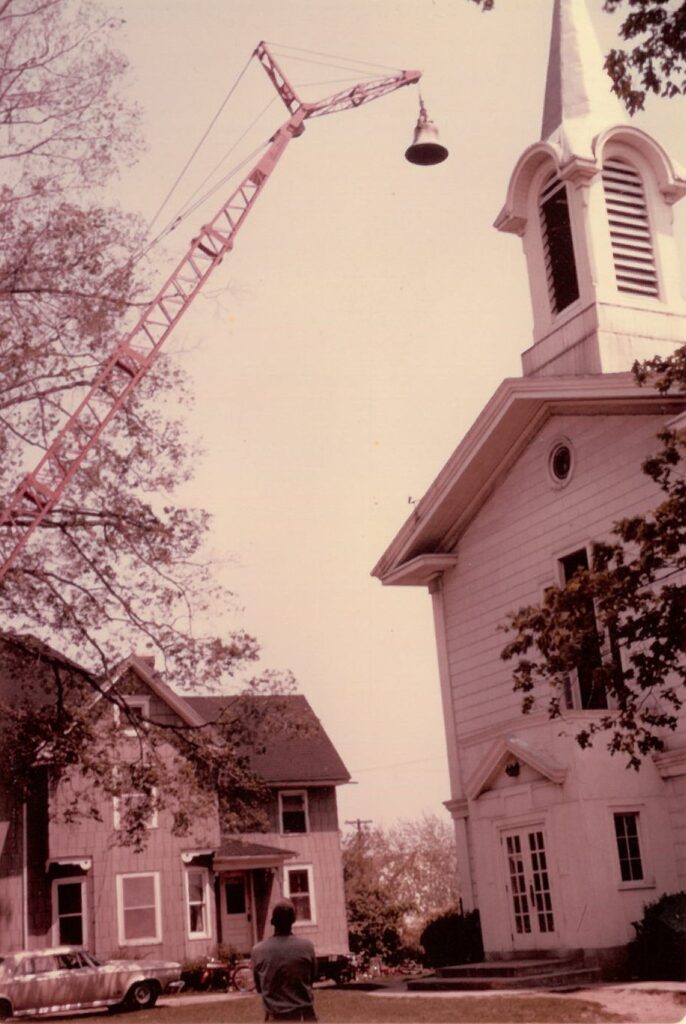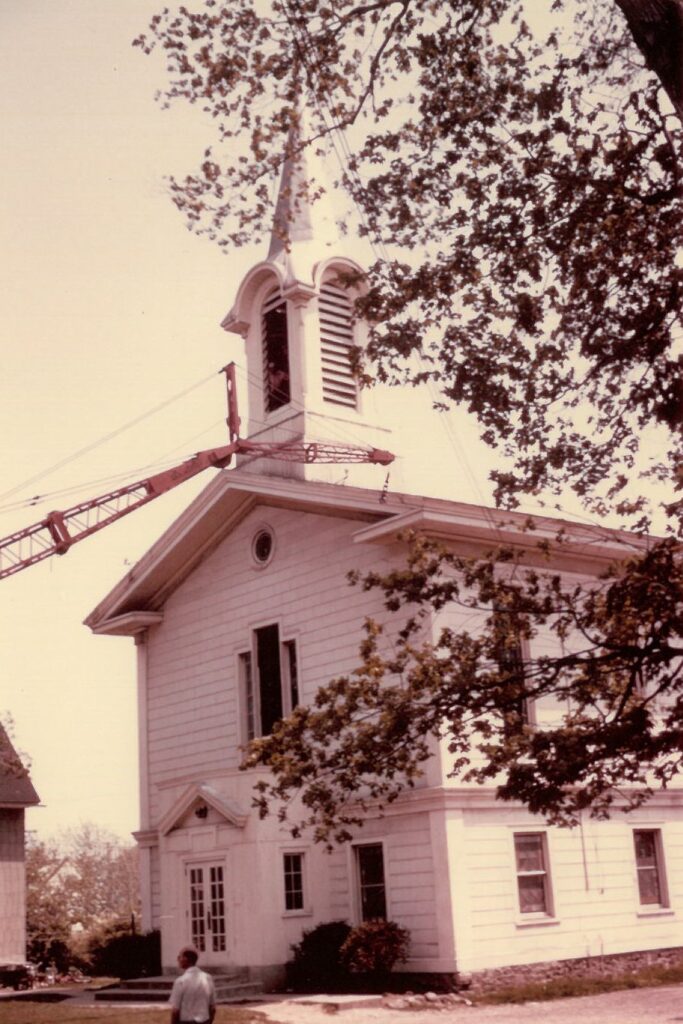Our History
Our church began in 1832 at nearby Buckbee’s Corners, just north of where Chili Avenue and Union Street intersect. The early Methodist Society held worship services in a cobblestone school house before the brick church was built.
In 1852, the church voted to divide so that each church might more effectively minister to a scattered constituency who traveled by horse and buggy. The First Methodist Church of North Chili was incorporated on February 8, 1853 and a new church was constructed on Buffalo Road in 1854.
This church eventually outgrew this building and in 1964 built our current facility at the corner of Buffalo Road and Westside Drive. In April of 1968 the church name was changed to The United Methodist Church of North Chili.
-From Our Celebration of the 150 Year History of the United Methodist Church of North Chili 1853-2003
Historical Notes
In 1832, the First Methodist Church in the town of Chili was organized near Buckbee’s Corners. This first church continued to minister to the spiritual needs of the community for nearly three quarters of a century.
In 1852, the parish was divided so that the church might more efficiently minister to her scattered constituency. The railroad seemed to be the proper line of division. This first church ministered to the community south of the railroad, while the new north society was to minister to those living north of the railroad.
According to our records of January 10, 1853, a subscription list was pro- vided for the purpose of purchasing a lot upon which to build the new church.
On February 8, 1853, a meeting was called to organize a Methodist Society in North Chili. Presiding Elder Micah Seager was in charge of the meeting, and the Rev. Samuel Gruendike was present.
On February 17, 1853, marked the election of Edmund W. Howell, Franklin Cate, and Alexander Rumsey to arrange for the erection of a substantial house of worship. Specifications for this building called for dimensions of 36 x 52 feet on the ground, two stories high, 28′ posts, 8′ basement, and 28′ for audience room. The contract was given on April 1, 1853 to Isaac Simmons, with agreement to be finished eight months hence, furnishings included. The total cost was $4,370 plus an additional $350 for the bell. During these months, the women were busily engaged in making cushions for the pews, while the men were installing four wood stoves and oil lamps.
On June 4, 1854, during the pastorate of the Reverend S. C. Church, this new building was dedicated. In the early years at Communion Services, a common pewter cup was passed from member to member as they partook of the Sacrament and renewed their vows to God. This cup is still in existence.
A meeting was held on January 28, 1861 of the following trustees: Stephen Angell, John Clark. Isaac Simmons, Sylvester Nurse, Lonson Smith, Sylvester Spencer, Harvey Harriman, Harvey Clark, William Campbell, Benjamin Edmmons, Edmund Howell, Robert Fulton, and Levi Fulton. They agreed that the church and property should be insured, and that each subscriber had to pay annually, for five years, the amount subscribed to him.
In 1871, Catherine Rumsey died, bequesting $100 to the Sunday School. It was voted to use part of it to establish a Sunday School Library, and the remainder to be banked at 6% interest. In August, they purchased 100 volumes called the Centennial Library for $25.05.
During the pastorate of the Reverend Z. Hurd, the women banded together throughout Methodism to form the Women’s Foreign Missionary Society on August 22, 1882. Locally, they gathered at the home of Mrs. George Baldwin and had 13 charter members.
In 1888, the women of the church collected $295 to pay for the re-shingling and re-decorating of the church. In 1891, $20 was raised for the church library, the first raised in over 20 years.
In 1892, trustees A. H. Gridley, J. S. Clark, Harlo Kingsbury, J. B. Hutchings, B. F. Cummings, and Albert Smith met and adopted the following resolution: Before any meeting could be held in the church, it required the con- sent of the trustees in writing.
In 1896, $10 of Miss Rumsey’s bequest was expended for singing books for the Sunday School.
In 1897, the Reverend J. L. Clark called the men of the church together, and it was decided to build a parsonage. During the next year, the Reverend Allatt and family lived in the Sunday School rooms of the church while the parsonage was being constructed. Mr. H. H. Clark and Mr. G. H. Baldwin each furnished $200 at 5% interest to meet a payment on the building. Two years later, a fence was put in back of the parsonage.
The church acquired its first furnace in 1901 with money raised by the Ladies Society. Until this time, the church was heated with the original wood stoves.
In 1907, the ladies of the church proposed to install new windows in the church, and the trustees voted to give them the old windows. It was at this time that our present leaded stained glass windows were installed in honor of the names that appear on them.
The following year, James Pengelly purchased 5 bushels of lime and 2 bags of cement so that the members could build a wall under the barn.
In April of 1909, a new line fence was built on the east side of the church, and sufficient posts were erected for hitching purposes. Also, Mr. N. B. Adams bought window fasteners for the basement windows. In November, a well was drilled at the south end of the west porch of the parsonage. It is 27′ deep. Little did they realize that over forty years later it would serve the church and school children.
At the same time, Mr. Adams wrote to Robert Gundry offering him $15 for his shed. In December, Mr. Gundry answered, refusing the offer. Two years later, the trustees voted that Mr. Gundry’s wagon be hoisted to the top of his shed so that the shed could be utilized.
An interesting notation in the trustees minutes during this period indicates a bill for $1.50 for horse rental for the pastor’s wife.
During the pastorate of the Reverend E. A. Matthews, the Christian Endeavor was renamed the Epworth League. Mrs. Matthews was a guiding hand to the youth during her stay.
The Reverend W. H. White, while serving here from 1911 to 1913, organized a very successful Mens’ Brotherhood. He was a sincere man who lived his Christianity.
In the year 1913, Mr. L. J. Morey was paid $3.00 to repair the cistern. Eaves troughs were put on the parsonage porch roof by Mr. J. B. Langrn end. Also, the trustees posted notices in the church sheds to this effect: “No more bills be posted or nuisances be committed in the sheds.” Mr. Lannmead put two ten gallon cans in the sheds, and put a box over them. The following year, they agreed to let the pastor cement the box down.
At this period, a new Communion Service was purchased which consisted of trays with tiny glasses, eliminating the use of the common cup.
In 1914, during the pastorate of the Rev. F. H. Dickerson, the Ladies Aid Society redecorated the church while the Philathia Class purchased new carpets. At this time, a pipe was installed to connect the furnace with the guest room of the parsonage.
In 1917, the trustees voted to purchase a new stove for the parsonage, if the price did not exceed $50. It was not until 1921 that a bathroom was installed in the parsonage. This was done by Waltrum of Spencerport.
During the next years, the people of the church labored hard to keep it going, despite hard times at home. It was a solace for their thoughts in troubled times. Some of the high spots of these later years were during the pastorates of our five former ministers who are still active in God’s work: In 1932, Rev. James M. Hemming helped organize the first daily vacation bible school. This has been a summer feature of our church program almost continually since then. In 1937 to 1942, Rev. Clifford Frost developed most effectively a vital program of Christian Stewardship. In 1942, 1943, Rev. Carlyle Smith brought a fresh spirit of Evangelism to the church. In 1943, 1945, Rev. Glen Moore carried on with a vital program, especially among the young people. In 1945, 1946, Rev. John McKnight preached Christian Brotherhood among all men.
About 1935, Lyle Jones, an Eagle Scout, son of the Rev. Elmer Jones, started the Boy Scout Troop in North Chili.
During the early forties, the Women’s Foreign Missionary Society and the Ladies Aid Society were consolidated into the Women’s Society of Chris, tian Service. In the late forties, the younger women of the church formed a Junior Women’s Society to meet in the evening. This answered the need of young mothers who could not attend the afternoon meetings of the Women’s Society of Christian Service.
In 1946, Stanley Deuel was given the job of tearing down the church sheds, for which he paid $50. The two sheds belonging to Fred Hutchings were left, as they were full of coal. The following year, the church steeple was repaired, at a cost of $440, to prevent its swaying, and a new lightning rod installed. A new roof was put on at this time, costing $482. The church barn was torn down in 1948 and the lumber sold.
During 1949, the church furnace was removed and a new automatic heating plant installed. It is a warm-air circulating unit which burns fuel oil.
In the fall, the trustees held an auction in the new building on Buffalo Road belonging to Mr. James Voorhees and Mr. Fred Gruendike. The whole church responded to the call for live stock, baked goods, old clothing, furniture, and anything else that could be sold. The amount of $906.28 was cleared for the purpose of enlarging our building and repair fund.
The church furnace room was made into a kitchen, with cupboards built by Yale Deuel and painted by Mr. and Mrs. Wilbur Gruendike. A stove was installed and a sink was donated. Recently, a refrigerator was given by a Rochester friend. In order to supply this new kitchen with towels and utensils, a shower was held in the church.
A spaghetti supper in 1950, at $35 a plate, highlighted a plan whereby a silver dollar was given to each person agreeing to enlarge it within 60 days. This money was to be used for the building fund and the plan netted $261.27.
During the years of 1946 to 1950, Dr. Samuel A. Keen was our pastor. With his wisdom, skill, and devotion to duty, he inspired the congregation to enter upon a new era of Christian growth. As noted above, many material improvements were made in the church building. Also, great growth was made in our membership and active stewardship. Dr. Keen literally gave his all for our church.
In June 1951, the Rev. Herbert Burdsall and family moved into the parson- age. Under their inspired leadership, the new era begun in 1947 was not only continued but has developed into .a full sized expansion movement in all departments of church activity. The Junior Women’s Society completely remodeled the kitchen, changing the stairway, erecting a partition to make an entry way, laying a new floor of rubber tile, installing an Anderson window, and purchasing an American kitchen ‘complete with sink, cupboards, and base cabinets.
The following year, the two Women’s Societies united, meeting on the second Wednesday evening of each month. This combined group had hard- wood flooring laid throughout the downstairs of the parsonage.
People began to take notice of our church at this time. The spire had been illuminated at night so that it might be seen far away to remind people that their church was near them at all times. The bulletin board was renovated and connected to the timer controlling the spire and circular window. At Christmas time, a Nativity scene was erected by the MYF and painted by D. Beaman, one of the young people. This also was controlled by the timer.
A new furnace and stoker were installed in the parsonage. All the stained glass windows in the church were checked, and those needing repair were leaded. After a concert by the A Capella Choir of Roberts Wesleyan College, during which time a board in the platform cracked, the platform was repaired. Several handbills were found under the structure advertising a meeting at which Fred Hutchings was going to preach and the yard to be lit up.
In 1952, Mrs. Wilbur Gruendike was dean of a very successful Daily Vacation Bible School. This past summer Mrs. Donald Mitchell headed the school. Enrollment exceeded 50 both years.
For the past two years, the church sanctuary has been opened at all times for prayer and meditation. Members and friends alike are invited to seek a place apart for personal devotions.
In January 1953, the property to the south and east of the church was purchased from the O’Brien sisters for future expansion and parking facilities. Plans for the addition are in the hands of Mr. Arthur Pohle and the trustees at this time. We appreciate the generosity of Mr. Pohle in giving his time and effort toward our project.
This fall, it was voted to rent the basement of the church to the Churchville-Chili School to be used for a classroom. Because of our growing Church School and the need for more individual meeting rooms, a contract was let for the erection of two double garages to be built south of the parsonage.
Our choir has been rejuvenated through special efforts of the director, Mrs. Raymond Stuart. New robes add to the beauty of the service. Because of the enthusiasm of the members of the choir, an organ fund was formed under the supervision of Mrs. Stuart Carlisle.
Because of the numerous gifts of beauty given our church in recent months, it was voted to obtain a gift book to record the gifts and the names of the donors.
Now, we are about to enter the second century of the history of our church. Our forefathers labored and prayed to make our assembly a holy place. May we who follow swiftly on, each contribute our prayers and efforts to maintain a sacred place of worship to mold the lives of the youth as one by one they enter our portals.
“An angel paused in its downward flight,
With a seed of truth and love and right,
And said, ‘0 where shall this seed be sown
To yield most fruit when larger grown?’
The Saviour heard and said as He smiled,
`Place it at once in the heart of a child’.”
“Feed My Lambs.”
Mrs. Grace Pengelly
Mrs. Jean Ellinwood
From 100th Anniversary Program November 13, 14, 15, 1953









